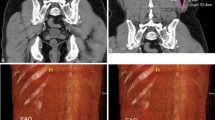Abstract.
Lumbar hernia is classically described as arising from the superior (Grynfeltt's) lumbar triangle or the inferior (Jean-Louis Petit's) lumbar triangle. The present anatomical study based on a computed tomography examination performed in a patient with lumbar hernia, has led to the suggestion that lumbar hernias cross the lumbar wall through a musculoaponeurotic tunnel, whose deep and superficial openings are the superior and inferior lumbar triangles, respectively.
Similar content being viewed by others
Author information
Authors and Affiliations
Additional information
Electronic Publication
Rights and permissions
About this article
Cite this article
Guillem, P., Czarnecki, E., Duval, G. et al. Lumbar hernia: anatomical route assessed by computed tomography. Surg Radiol Anat 24, 53–56 (2002). https://doi.org/10.1007/s00276-002-0003-z
Received:
Accepted:
Published:
Issue Date:
DOI: https://doi.org/10.1007/s00276-002-0003-z




